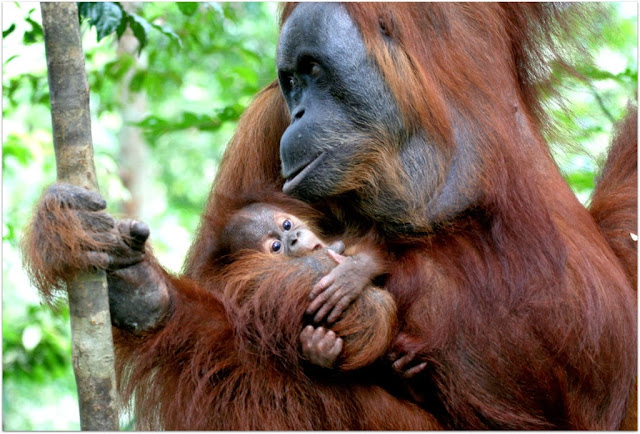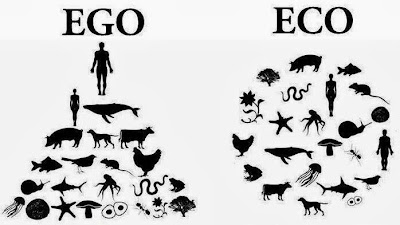Observing free living Wild Orangutans in their Forest homes is a truly beautiful experience. There is a grace and
humbleness to our gentle tree-dwellin' cousins, whose very existence
provides a living window into our not-so-distant forest-bound past..
It's obvious why we are so fascinated by Orangutans! they are the only great Ape species, apart from Humans, surviving on this side of the world (South-East Asia).
Chimps, Bonobos and Gorillas never left Africa!
Just look at the love this mother orangutan clearly has for her young.Chimps, Bonobos and Gorillas never left Africa!
Perhaps our fascination for Orangutans stems
from a naturally anthropocentric world-view which
makes perfect sense when you think about it... we share 96% of the same genetic code and have a recent
ancestor just 10-14 million years ago when our evolutionary paths 'diverged'.
I suppose up until now in our evolutionary journey this human-centered world-view has been absolutely essential to our survival! However now it is clear we need to make the evolutionary leap from an anthropocentric or human-centered world-view to a more holistic 'bio-centric' perspective that recognizes the inherent value of all living beings which form the living biosphere.
I suppose up until now in our evolutionary journey this human-centered world-view has been absolutely essential to our survival! However now it is clear we need to make the evolutionary leap from an anthropocentric or human-centered world-view to a more holistic 'bio-centric' perspective that recognizes the inherent value of all living beings which form the living biosphere.
Sometimes I even feel like the focus on our red-haired cousins overshadows all the forgotten species of the rainforest who are often equally rare
and endangered compared to the more charismatic mega-fauna which dominate conservation efforts (Tigers, Rhino, Elephant).
As an example, check out this awesome article 'Forgotten species: the overlooked Sumatran striped rabbit' describing
one of the many rare and threatened species found in Sumatran rainforest.
What a funky little critter! I had no idea they existed until recently.
What a funky little critter! I had no idea they existed until recently.

The beauty of Orangutan conservation is that if we protect and restore Orangutan habitat, we're automatically conserving a huge range of species which make up the super-organism of a Forest eco-system.. (not just animals.. also plants, fungi, bacteria, the whole web)
This is why we call Orangutans
'Flagship' species, they are ambassadors for the entire eco-system which form
their habitat and can teach us humans so much about our own inter-dependency with ecological communities!
And now reporting from Indonesia...
And now reporting from Indonesia...
First Meeting with the National Park and Restoration Field Staff
I've finally arrived in Sumatra for my 12 month AYAD assignment with the Orangutan Information Centre (OIC) and have just spent 2 weeks based inside the national park living with the Restoration team in the field cabin now surrounded by quikcly regenerating rainforest! (with primary forest just a few hundred meters away)
The Team are successfully restoring 100's
of hectares of degraded lands inside Gunung Leuser National Park which
were illegally cleared by an Oil Palm company... Finally I get to see with my
own eyes this amazing project in action.
As well as restoring forest ecology, the team have successfully re-established the authenticity
of National Park boundaries. By working with local communities the Primary
Forest within Gunung Leuser National Park is now a secured habitat for
Orangutan and many other endangered species (including Elephants, Tigers and
perhaps Sumatran Striped Rabbits).
Below are some
photo's taken from the OIC restoration site in Gunung Leuser National Park.. In
the foreground is regenerating rainforest and in the background is the
'Primary' forest.
Every morning we hear Orangutan, Gibbons, Hornbills and Argus
Pheasants calling from the intact primary forest.. and not once have I heard
the sound of chainsaws or bulldozers! Success!
BEFORE (2012 August)
AFTER (September 2013)
The Restoration Cabin 'Before and After'
Panut Hadisiswoyo,
Founder and Director of OIC planting a Tree with his son. Walking the Talk and
educating the next generation on environmental stewardship.
As well as continuing
to propagate plants in the nurseries and tree planting activities we are
working together in improving the nursery systems and propagation
methodologies as well as critical monitoring of biodiversity recovery.
Thanks to a generous
donation from school teachers in Sydney, Australia, we now have 5 high
quality HD camera traps for biodiversity monitoring.
Stay tuned for biodiversity reports and field updates!
Stay tuned for biodiversity reports and field updates!
The health of the regenerating forest is
self-evident. Absolute abundance where Life creates the
conditions that sustain more life! For me this is the real magic of Forest
restoration, an evolved mechanism for 'self-healing' the eco-system (or colonizing degraded sites such as volcanoes).
In
restoration ecology we are literally working 'with' nature!
Already species are
beginning to flower and produce seeds, attracting seed-dispersing bird and
mammal species which diversifies and speeds up the regeneration and habitat
recovery process, it becomes a positive feedback loop and where nature does
most of the work and the site is usually 'captured' (closed canopy) within a few years.
The project gets a lot of visitors, locally and from around the world, who come to support the project and learn about Forest Restoration and Biodiversity Conservation.
Garry Sundin from Orangutan Odysseys bring tour groups to the site for Orangutan education and tree planting.. what a fantastic business model for eco-tourism! (a portion of the tour cost goes directly towards the OIC reforestation program).
That's it from me, I
hope to update my blog regularly and share with you all stories from inside the
national park.. including any new species from the camera traps survey!
If you want to help the project and make a donation I'm working with Kelvin Davies from the Rainforest Information Centre in Australia on the 'Orangutan Revolution' project and we have started a crow-funding campaign for planting more trees in Sumatra!
CLICK HERE to DONATE for this Critical Habitat Restoration Program..



















No comments:
Post a Comment